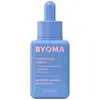What's inside
What's inside
 Key Ingredients
Key Ingredients

 Benefits
Benefits

 Concerns
Concerns

No concerns
 Ingredients Side-by-side
Ingredients Side-by-side

Water
Skin ConditioningGlycerin 14.5%
HumectantDiethoxyethyl Succinate
Solvent1,2-Hexanediol
Skin ConditioningPanthenol
Skin ConditioningPolyglutamic Acid
Skin ConditioningPanax Ginseng Root Extract
EmollientSodium PCA
HumectantXylitylglucoside
HumectantAnhydroxylitol
HumectantXylitol
HumectantHydrolyzed Hyaluronic Acid
HumectantArginine
MaskingMethionine
Skin ConditioningCysteine
AntioxidantSodium Hyaluronate
HumectantHyaluronic Acid
HumectantHouttuynia Cordata Extract
Skin ConditioningTremella Fuciformis Extract
HumectantSodium Hyaluronate Crosspolymer
HumectantBeta-Glucan
Skin ConditioningHydrolyzed Sodium Hyaluronate
Skin ConditioningAdansonia Digitata Seed Extract
Skin ConditioningSophora Angustifolia Root Extract
Skin ConditioningMalus Domestica Fruit Extract
AntioxidantPunica Granatum Fruit Extract
AntioxidantPrunus Serotina Fruit Extract
MaskingVaccinium Macrocarpon Fruit Extract
AstringentButylene Glycol
HumectantPortulaca Oleracea Extract
Skin ConditioningCitrullus Lanatus Fruit Extract
Skin ConditioningGardenia Florida Fruit Extract
Skin ConditioningDextrin
AbsorbentDipotassium Glycyrrhizate
HumectantGlucose
HumectantSodium Polyacryloyldimethyl Taurate
Emulsion StabilisingSodium Polyacrylate
AbsorbentAcrylates/C10-30 Alkyl Acrylate Crosspolymer
Emulsion StabilisingPentylene Glycol
Skin ConditioningCarbomer
Emulsion StabilisingEthylhexylglycerin
Skin ConditioningCaprylyl Glycol
EmollientWater, Glycerin 14.5%, Diethoxyethyl Succinate, 1,2-Hexanediol, Panthenol, Polyglutamic Acid, Panax Ginseng Root Extract, Sodium PCA, Xylitylglucoside, Anhydroxylitol, Xylitol, Hydrolyzed Hyaluronic Acid, Arginine, Methionine, Cysteine, Sodium Hyaluronate, Hyaluronic Acid, Houttuynia Cordata Extract, Tremella Fuciformis Extract, Sodium Hyaluronate Crosspolymer, Beta-Glucan, Hydrolyzed Sodium Hyaluronate, Adansonia Digitata Seed Extract, Sophora Angustifolia Root Extract, Malus Domestica Fruit Extract, Punica Granatum Fruit Extract, Prunus Serotina Fruit Extract, Vaccinium Macrocarpon Fruit Extract, Butylene Glycol, Portulaca Oleracea Extract, Citrullus Lanatus Fruit Extract, Gardenia Florida Fruit Extract, Dextrin, Dipotassium Glycyrrhizate, Glucose, Sodium Polyacryloyldimethyl Taurate, Sodium Polyacrylate, Acrylates/C10-30 Alkyl Acrylate Crosspolymer, Pentylene Glycol, Carbomer, Ethylhexylglycerin, Caprylyl Glycol
Water
Skin ConditioningGlycerin
HumectantButylene Glycol
HumectantSqualane
EmollientSodium Stearoyl Glutamate
CleansingAmmonium Acryloyldimethyltaurate/Vp Copolymer
Dipropylene Glycol
HumectantCeramide NP
Skin ConditioningCaprylic/Capric Triglyceride
MaskingCholesterol
EmollientPhytosphingosine
Skin ConditioningStearic Acid
CleansingOleic Acid
EmollientHydroxyacetophenone
AntioxidantPolyglyceryl-4 Oleate
EmulsifyingHydroxyethyl Acrylate/Sodium Acryloyldimethyl Taurate Copolymer
Emulsion StabilisingHydrogenated Lecithin
EmulsifyingCaprylyl Glycol
EmollientGlyceryl Oleate
EmollientLactic Acid
BufferingEthylhexylglycerin
Skin ConditioningHydrogenated Rapeseed Alcohol
EmollientSorbitan Isostearate
EmulsifyingSodium Phytate
Xanthan Gum
EmulsifyingDipotassium Glycyrrhizate
HumectantTocopherol
AntioxidantCaprylhydroxamic Acid
Water, Glycerin, Butylene Glycol, Squalane, Sodium Stearoyl Glutamate, Ammonium Acryloyldimethyltaurate/Vp Copolymer, Dipropylene Glycol, Ceramide NP, Caprylic/Capric Triglyceride, Cholesterol, Phytosphingosine, Stearic Acid, Oleic Acid, Hydroxyacetophenone, Polyglyceryl-4 Oleate, Hydroxyethyl Acrylate/Sodium Acryloyldimethyl Taurate Copolymer, Hydrogenated Lecithin, Caprylyl Glycol, Glyceryl Oleate, Lactic Acid, Ethylhexylglycerin, Hydrogenated Rapeseed Alcohol, Sorbitan Isostearate, Sodium Phytate, Xanthan Gum, Dipotassium Glycyrrhizate, Tocopherol, Caprylhydroxamic Acid
 Reviews
Reviews

Ingredients Explained
These ingredients are found in both products.
Ingredients higher up in an ingredient list are typically present in a larger amount.
Butylene Glycol (or BG) is used within cosmetic products for a few different reasons:
Overall, Butylene Glycol is a safe and well-rounded ingredient that works well with other ingredients.
Though this ingredient works well with most skin types, some people with sensitive skin may experience a reaction such as allergic rashes, closed comedones, or itchiness.
Learn more about Butylene GlycolCaprylyl Glycol is a humectant and emollient, meaning it attracts and preserves moisture.
It is a common ingredient in many products, especially those designed to hydrate skin. The primary benefits are retaining moisture, skin softening, and promoting a healthy skin barrier.
Though Caprylyl Glycol is an alcohol derived from fatty acids, it is not the kind that can dry out skin.
This ingredient is also used as a preservative to extend the life of products. It has slight antimicrobial properties.
Learn more about Caprylyl GlycolDipotassium Glycyrrhizate comes from licorice root.
Extracts of licorice have demonstrated to have antibacterial, anti‐inflammatory, antiviral, antioxidant properties.
One component, glabridin, has extra potent antioxidant and soothing properties. It has also been found to block pigmentation from UVB rays in guinea pigs.
Licorice Root also contains a flavonoid. Flavonoids are a natural substance from in plants. Flavonoids also have antioxidant properties.
Another component, glycyrrhizin, has been found to have anti-inflammatory and antimicrobial benefits. This may make licorice root extract effective at treating acne. However, more research is needed to support this.
Liquiritin is one of the flavone compounds found in licorice. It has been found to help lighten skin by preventing tyrosinase from reacting with tyrosine. When the two react, protein is converted to melanin. Melanin is the substance in your body that gives your features pigmentation.
Licorice root is native to Southern Europe and Asia. It has been used in traditional Chinese medicine to help with respiratory issues.
Learn more about Dipotassium GlycyrrhizateEthylhexylglycerin (we can't pronounce this either) is commonly used as a preservative and skin softener. It is derived from glyceryl.
You might see Ethylhexylglycerin often paired with other preservatives such as phenoxyethanol. Ethylhexylglycerin has been found to increase the effectiveness of these other preservatives.
Glycerin is already naturally found in your skin. It helps moisturize and protect your skin.
A study from 2016 found glycerin to be more effective as a humectant than AHAs and hyaluronic acid.
As a humectant, it helps the skin stay hydrated by pulling moisture to your skin. The low molecular weight of glycerin allows it to pull moisture into the deeper layers of your skin.
Hydrated skin improves your skin barrier; Your skin barrier helps protect against irritants and bacteria.
Glycerin has also been found to have antimicrobial and antiviral properties. Due to these properties, glycerin is often used in wound and burn treatments.
In cosmetics, glycerin is usually derived from plants such as soybean or palm. However, it can also be sourced from animals, such as tallow or animal fat.
This ingredient is organic, colorless, odorless, and non-toxic.
Glycerin is the name for this ingredient in American English. British English uses Glycerol/Glycerine.
Learn more about GlycerinWater. It's the most common cosmetic ingredient of all. You'll usually see it at the top of ingredient lists, meaning that it makes up the largest part of the product.
So why is it so popular? Water most often acts as a solvent - this means that it helps dissolve other ingredients into the formulation.
You'll also recognize water as that liquid we all need to stay alive. If you see this, drink a glass of water. Stay hydrated!
Learn more about Water